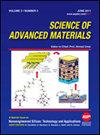Feasibility and Safety of Regenerated Wild Antheraea pernyi Silk Fibroin/Polyvinyl Alcohol Scaffold in Repair of Calcaneal Tendon Defects
IF 0.9
4区 材料科学
引用次数: 0
Abstract
This research discussed the value of regenerated wild Antheraea pernyi silk fibroin (RWSF)/polyvinyl alcohol (PVA) nanofiber scaffold (NFS) in repairing the calcaneal tendon defect (CTD). RWSF was prepared by saturated salt solution (SSS) method, and then RWSF/PVA NFS was prepared by electrospinning using RWSF and PVA as raw materials. Fourier transform infrared spectroscopy (FTIS) was applied to detect the characteristic absorption spectra of WSF, RWSF, and RWSF/PVA. The ultimate tensile strength (UTS) and elongation at break (BE) of RWSF/PVA NFS were analyzed by mechanical tester. The cytotoxicity of RWSF/PVA NFS was determined by MTT assay. 18 SD rats were randomly rolled into an operation group, control group, and experimental group, with 6 rats in each. Meanwhile, 27 rats were randomly grouped into three: blank group, model group, and experimental group. HE staining, Masson staining, and biomechanical properties of the regenerated fibers were analyzed in the calcaneal tendon tissues (CTTs) of rats in different groups. Expressions of tendon-related genes and inflammatory factors in CTTs in various groups were compared by RT-PCR. The results revealed that the UTS and BE of PVA and RWSF/PVA were much higher than those of natural acellular tendon (P <0.01). On day 15 after operation, the hair in the incision area of rats in the Ope, Con, and Exp groups grew normally. The implanted RWSF/PVA NFS in the Exp group adhered closely to the surrounding muscle tissue and degraded gradually, and there were still trace inflammatory cells at the junction. The tendon cross sectional area (CSA) in the Model group and RWSF/PVA group was greatly higher based on that in the Blank group (P <0.05), and the UTS in of Model group was much higher than that in the Blank group but lower to the Model group, showing great differences with P <0.05. The Collagen I, Collagen III, TGF-β1, BGN, and TNMD in CTTs in the RWSF/PVA group were higher to the Model group 2 months ago (P <0.05); while Collagen I, TGF-β1, BGN, and TNMD were still much higher 3 months later (P <0.01) but Collagen III was lower with an obvious difference (P <0.05). At 5 months, IL-1β and TNF-α in the RWSF/PVA group were greatly lower in contrast to the model group, presenting extremely obvious differences (P <0.001). The results indicated that the RWSF/PVA NFS exhibited a good biocompatibility, can accelerate the collagen secretion, promote TGF-β1, inhibit IL-1β and TNF-α factors, thus being conductive to repair of CTD. In conclusion, RWSF/PVA NFS possessed a good biocompatibility, can promote collagen secretion, elevate the TGF-β1, and inhibit IL-1β and TNF-α factors to participate in calcaneal CTD repair, showing a high value in repair of CTD.再生野生柞蚕丝素/聚乙烯醇支架修复跟腱缺损的可行性及安全性
本研究探讨了再生野生柞蚕丝素蛋白(RWSF)/聚乙烯醇(PVA)纳米纤维支架(NFS)修复跟骨肌腱缺损(CTD)的价值。采用饱和盐溶液法制备RWSF,然后以RWSF和PVA为原料,通过静电纺丝法制备RWSF/PVA NFS。采用傅立叶变换红外光谱法(FTIS)检测了WSF、RWSF和RWSF/PVA的特征吸收光谱。用力学测试仪对RWSF/PVA NFS的极限拉伸强度(UTS)和断裂伸长率(BE)进行了分析。MTT法测定RWSF/PVA NFS的细胞毒性。18只SD大鼠随机分为手术组、对照组和实验组,每组6只。同时,将27只大鼠随机分为三组:空白组、模型组和实验组。分析了不同组大鼠跟骨肌腱组织中再生纤维的HE染色、Masson染色和生物力学特性。用RT-PCR方法比较各组CTT中肌腱相关基因和炎症因子的表达。结果表明,PVA和RWSF/PVA的UTS和BE均明显高于天然脱细胞肌腱(P<0.01)。术后第15天,Ope、Con和Exp组大鼠切口区毛发生长正常。Exp组植入的RWSF/PVA NFS与周围肌肉组织紧密粘附并逐渐降解,交界处仍有微量炎症细胞。模型组和RWSF/PVA组的肌腱截面积(CSA)在空白组的基础上显著增加(P<0.05),模型组的UTS远高于空白组,但低于模型组,与模型组相比差异有统计学意义(P<0.05)。RWSF/PVA组CTT中I型胶原、III型胶原、TGF-β1、BGN和TNMD均高于模型组(P<0.05);3个月后,I型胶原、TGF-β1、BGN和TNMD仍显著升高(P<0.01),而III型胶原降低,差异有统计学意义(P<0.05)。5个月时,RWSF/PVA组的IL-1β和TNF-α显著低于模型组,差异极为显著(P<0.001),可加速胶原分泌,促进TGF-β1,抑制IL-1β和TNF-α因子,有利于CTD的修复。总之,RWSF/PVA NFS具有良好的生物相容性,能促进胶原分泌,升高TGF-β1,抑制IL-1β和TNF-α因子参与跟骨CTD修复,在CTD修复中具有较高的价值。
本文章由计算机程序翻译,如有差异,请以英文原文为准。
求助全文
约1分钟内获得全文
求助全文
来源期刊

Science of Advanced Materials
NANOSCIENCE & NANOTECHNOLOGY-MATERIALS SCIENCE, MULTIDISCIPLINARY
自引率
11.10%
发文量
98
审稿时长
4.4 months
 求助内容:
求助内容: 应助结果提醒方式:
应助结果提醒方式:


